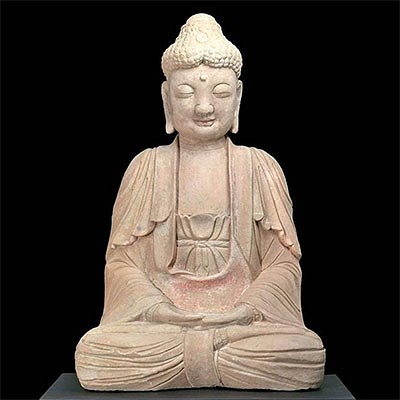Large Chinese Han Dynasty Pottery Horse Torso w/ TL
Lot 76a
About Seller
Artemis Gallery
686 S Taylor Ave, Ste 106
Louisville, CO 80027
United States
Selling antiquities, ancient and ethnographic art online since 1993, Artemis Gallery specializes in Classical Antiquities (Egyptian, Greek, Roman, Near Eastern), Asian, Pre-Columbian, African / Tribal / Oceanographic art. Our extensive inventory includes pottery, stone, metal, wood, glass and textil...Read more
Categories
Estimate:
$5,000 - $7,500
Absentee vs Live bid
Two ways to bid:
- Leave a max absentee bid and the platform will bid on your behalf up to your maximum bid during the live auction.
- Bid live during the auction and your bids will be submitted real-time to the auctioneer.
Bid Increments
| Price | Bid Increment |
|---|---|
| $0 | $25 |
| $300 | $50 |
| $1,000 | $100 |
| $2,000 | $250 |
| $5,000 | $500 |
| $10,000 | $1,000 |
| $20,000 | $2,500 |
| $50,000 | $5,000 |
| $100,000 | $10,000 |
| $200,000 | $20,000 |
About Auction
By Artemis Gallery
Feb 18, 2021
Set Reminder
2021-02-18 10:00:00
2021-02-18 10:00:00
America/New_York
Bidsquare
Bidsquare : Exceptional Antiquities, Asian, Ethnographic
https://www.bidsquare.com/auctions/artemis-gallery/exceptional-antiquities-asian-ethnographic-6373
Museum-worthy examples of Egyptian, Greek, Roman, Etruscan, Near Eastern, Far East / Asian, Pre-Columbian, African / Tribal, Oceanic, Native American, Spanish Colonial, Russian, Fossils, Ancient Jewelry, Fine Art, so much more! Artemis Gallery info@artemisgallery.com
Museum-worthy examples of Egyptian, Greek, Roman, Etruscan, Near Eastern, Far East / Asian, Pre-Columbian, African / Tribal, Oceanic, Native American, Spanish Colonial, Russian, Fossils, Ancient Jewelry, Fine Art, so much more! Artemis Gallery info@artemisgallery.com
- Lot Description
East Asia, China, Han Dynasty, ca. 206 BCE to 220 CE. A magnificent and sizable pottery horse head and torso formed from grey clay. Featuring a thick body with a central recessed spine, this lovely statue boasts a lively visage with bulging eyes, raised ears, a pronounced snout with flared nostrils, and an open mouth revealing his teeth and likely neighing. Presenting a neatly manicured mane, the ancient animal's neck is beautifully painted with lovely horizontal stripes of light blue on a cream ground. A light pink harness adorns his face. During the Han dynasty, the ancients placed such model figures in tombs to ensure a safe journey to the afterlife. Size: 21.5" L x 8.75" W x 18" H (54.6 cm x 22.2 cm x 45.7 cm)
During this period of Chinese history, horses came from the Ferghama Valley in Central Asia - present day Afghanistan. When elite individuals passed away, "walking" terracotta Ferghama horses displaying an immense degree of attention to detail, like this example, were created to carry the deceased into the hereafter. The horse, second only in importance to the dragon, was believed to possess magical powers. The number of horses owned by an individual ensured his high status in the afterlife.
Funerary sculptures like this piece are part of a class of artifacts called mingqi - sometimes known as "spirit utensils" or "vessels for ghosts". They became popular in the Han Dynasty and would persist for several centuries. Alongside figures like this one were musicians, athletes, animals, structures, and more. Even though they were mass produced, mingqi of the Han Dynasty often show a high level of detail and naturalism. These were designed to assist the po, the part of the soul of the deceased that remained underground with the body while the hun, the other part of the soul, ascended. According to scholars, caring for the po took on a new level of meaning in the Han period, with more elaborate rituals and tomb construction arising.
This piece has been tested using thermoluminescence (TL) analysis and has been found to be ancient and of the period stated. A full report will accompany purchase.
Provenance: private Los Angeles, California, USA collection, 1980s to 2000s
All items legal to buy/sell under U.S. Statute covering cultural patrimony Code 2600, CHAPTER 14, and are guaranteed to be as described or your money back.
A Certificate of Authenticity will accompany all winning bids.
We ship worldwide and handle all shipping in-house for your convenience.
#162233Missing legs. Head is removable. Repaired from several pieces with restoration over break lines. Expected surface wear with light abrasions and some nicks/chips, all commensurate with age. Otherwise, very nice with impressive remaining pigments and lovely earthen deposits throughout.Condition
- Shipping Info
-
All shipping is handled in-house for your convenience. Your invoice from Artemis Gallery will include shipping calculation instructions. If in doubt, please inquire BEFORE bidding for estimated shipping costs for individual items.
-
- Buyer's Premium



 EUR
EUR CAD
CAD AUD
AUD GBP
GBP MXN
MXN HKD
HKD CNY
CNY MYR
MYR SEK
SEK SGD
SGD CHF
CHF THB
THB
















